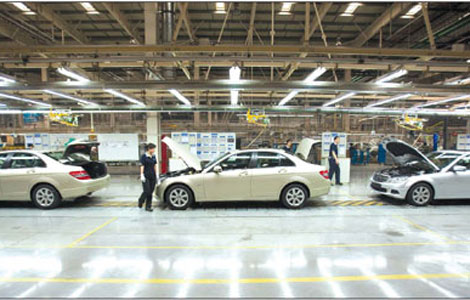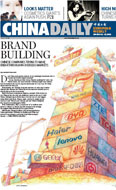Retail giants square up for rich pickings in China
Updated: 2011-03-04 10:24
By James Sinclair (China Daily European Weekly)
|
 |
Take a walk around one of Beijing's neighborhoods and you're more than likely to see a Walmart and a Carrefour, as well as many other hypermarket chains from around the world.
The hypermarket business in first-tier cities is fast reaching saturation, with fierce competition and little room left for newcomers. So retail giants are turning to China's dozens, if not hundreds, of smaller cities, tapping the retail growth that's emerging across China.
However, as global leaders move into smaller cities, transforming local retailers from traditional shops into more modern chains, they face new challenges.
All the top international chains are in China. For Walmart, Carrefour and Tesco, the world's top three players, China is now the fastest growing market worldwide.
Walmart has the largest hypermarket footprint of the three, generating 34 billion yuan (3.73 billion euros) in revenue through 189 stores in 101 cities. Carrefour has 159 stores in 47 cities and 37 billion yuan in revenue, while Tesco has 78 stores in 35 cities, generating 13 billion yuan. Many other international chains are also in the chase.
The trend is clear: International chains will expand rapidly. Tesco, for example, will likely open more floor space in China over the next five years than it has done in eight decades in its home country, the United Kingdom.
But Chinese chains still dominate the domestic market. Among them are China Resources Vanguard (CRV) and Lianhua Supermarket, among China's top five retail groups.
CRV generated 72 billion yuan in revenue in 2010 from 3,200 stores in more than 100 cities. In the past year, CRV opened more than 450 stores, including 60 large supermarkets. It plans to open 400 more this year, including 70 to 80 large supermarkets.
And the Chinese chains are becoming much more sophisticated when it comes to shopper experience.
Beijing Hualian Supermarket, one of China's top 20 chains, is among the most forward thinking. It is now seeking to differentiate against its international and domestic peers by developing a deeper understanding of the Chinese shopper and providing them with a better shopping experience.
Yet while the stronger Chinese chains are moving to better compete in bigger cities, international chains are heading into smaller cities. One of the most successful has been RT-Mart, the joint venture between Taiwan-based Ruentex Group and the Auchan Group from France.
RT-Mart enter China in 1997, a few years after Carrefour, with an astutely tailored approach. And instead of concentrating on bigger cities, RT-Mart secured prime properties in smaller cities. The result: RT-Mart recently surpassed Carrefour to become the largest international chain in China by retail sales.
However, Chinese chains are strongest in the smaller cities, with chains such as CRV and Lianhua Supermarket having grown from provincial strongholds. And they are still in the process of building national coverage.
For example, CRV has more than half of its stores in East China's Jiangsu province alone. This pattern is reflected in most provinces, with scores of regional chains growing from their provincial base. They tend to have about 100 outlets and revenues in the region of 1 billion to 5 billion yuan.
Behind them are hundreds of local chains growing from their municipal bases, often with 20-100 outlets and revenues ranging from 100 million yuan to 500 million yuan. Other chains may have just a handful of outlets in one or two cities.
As the international chains penetrate smaller cities, they will face these regional players, which are even moving into first-tier cities to compete against national and international chains. These regional chains are seeking to learn from their more sophisticated international and national counterparts, and a new source of global expertise has arrived in China to do just that.
The Independent Grocery Association (IGA), a US-based association of regional hypermarket and supermarket chains, recently established a chapter in China, with 20 members operating 2,500 stores so far.
IGA has started to train members, joining the University of Wuhan to establish an IGA Institute and cover modern retail management disciplines. IGA is also starting to use the combined scale of its members to generate greater negotiation power over suppliers than individual chains would have alone. Given this support, IGA will be an important force in the shaping of China's retail environment over the coming decade.
Another force will be acquisitions and consolidation. In addition to the normal consolidation drivers, such as achieving economies of scale, securing prime locations will be a critical driver for the chains.
And the best locations are in crowded urban cores, close to dense residential neighborhoods and commercial complexes. Clearly there are a finite number of these sites, and as regional chains have been in the smaller cities for more than a decade, they already occupy them.
In the past, international chains used their joint venture partners to leverage local relationships and gain access to good locations. At present, we are seeing the chains forming strategic relationships with property developers, or investing in commercial complexes - all with the intention of their stores becoming anchor tenants.
Another strategy is to acquire regional chains and their prime locations. This will bring two benefits. First, acquisitions will provide premium hypermarket players with new formats and brands, allowing them to play in smaller formats and mid-level positions better suited to smaller cities.
Second, acquiring chains will come with local know-how, including an understanding of brand preferences and consumer behavior in each province or city. Carrefour is a case in point. In July last year, Carrefour acquired 51 percent of Hebei Baolongcang, which operates 14 hypermarkets, mainly in smaller cities, recording net sales of 1.06 billion yuan in 2009. Now, the chains - which are focusing on China's next 600 cities - may soon have to start thinking about China's thousands of towns.
The author is managing partner and a consumer and retail specialist at InterChina Consulting, a strategy and M&A advisory firm headquartered in China.
E-paper

Factory fever
Despite auto manufacturing bubble scare, car giants gear up expansion of factories.
Dressed for success
Fabric of change
High spirits
Specials

Earthquake Hits Japan
A massive 8.8 magnitude quake hit the northeast coast of Japan on March 11,2011.

NPC & CPPCC sessions
Lawmakers and political advisers gather in Beijing to discuss major issues.

Slide: Japan quake
Devastating earthquake and tsunami left millions without water, electricity, homes or heat.
